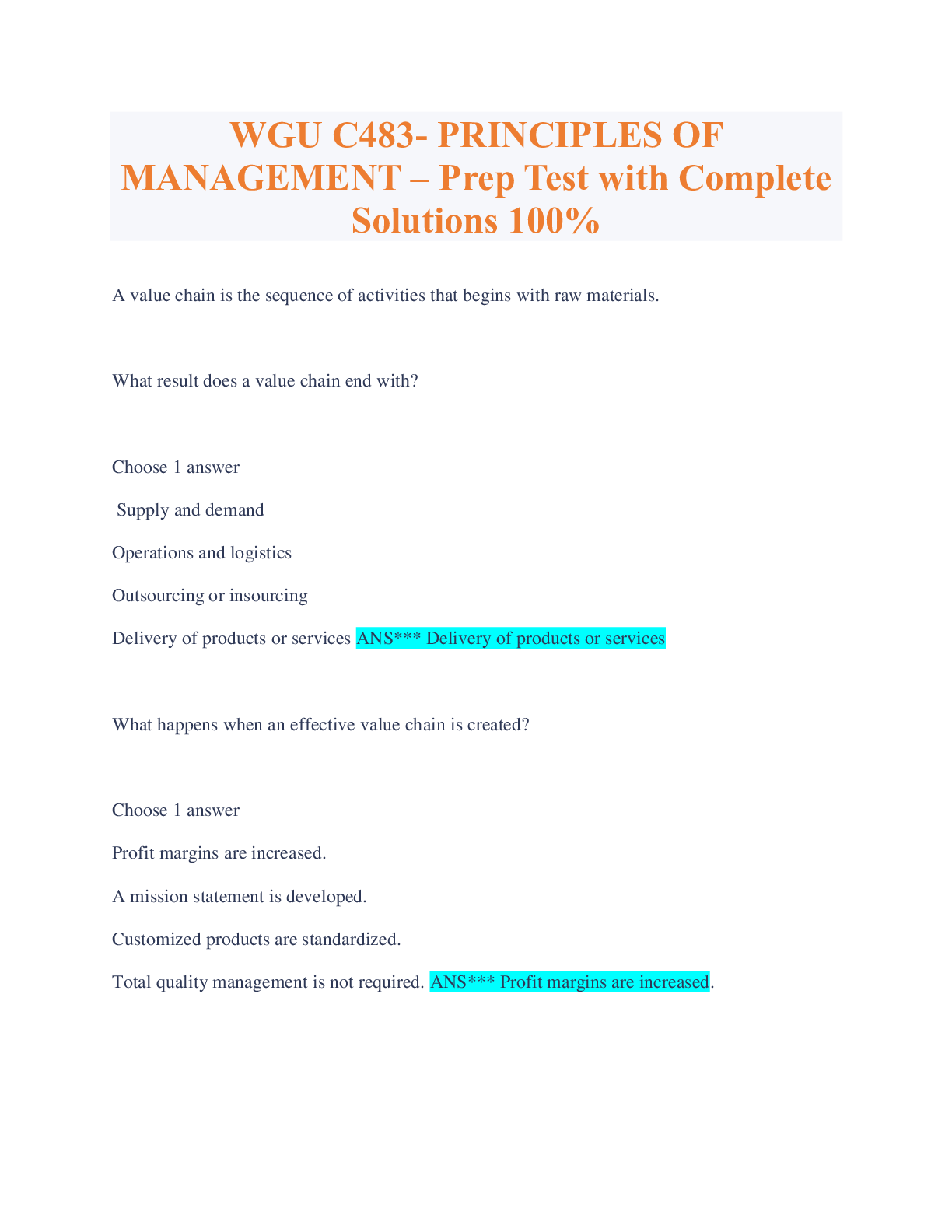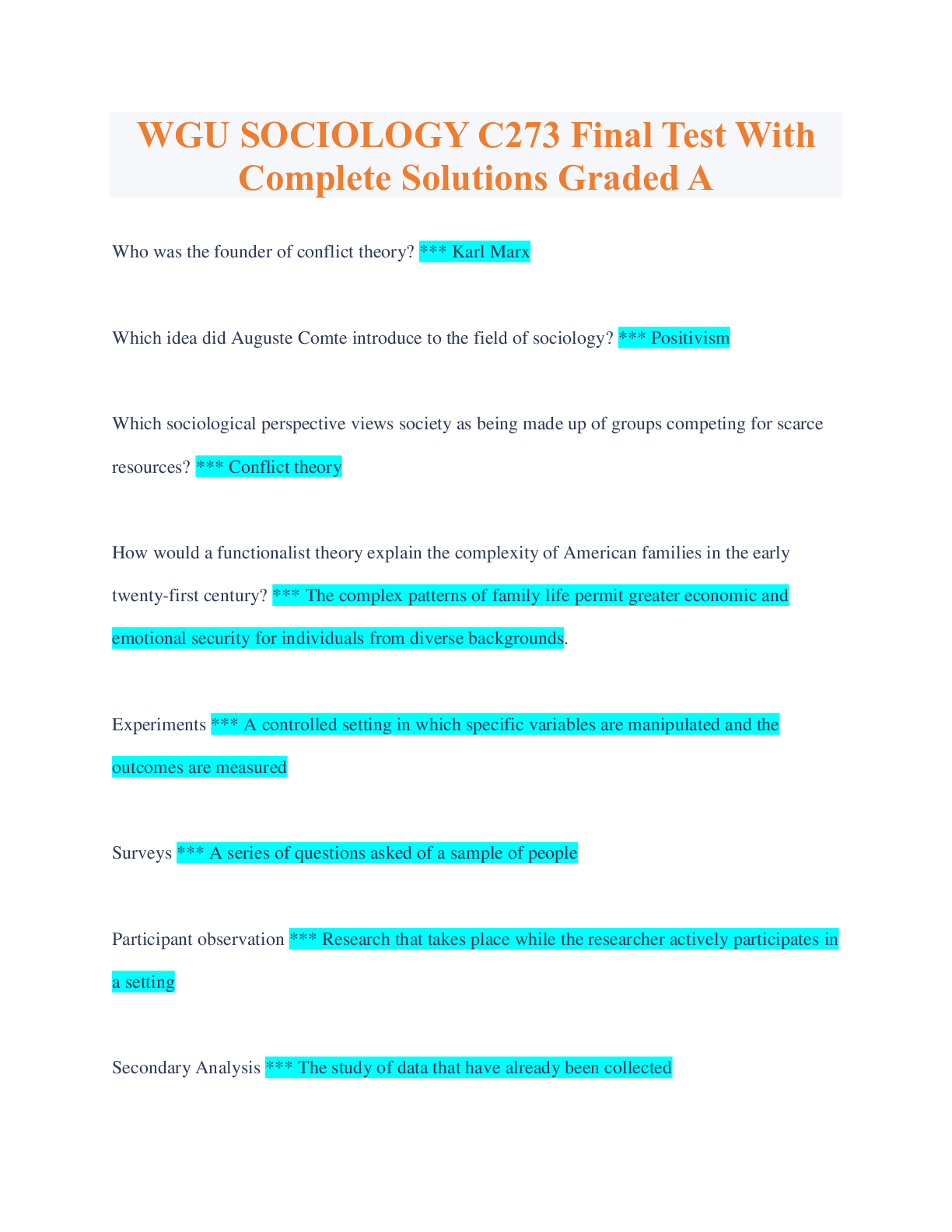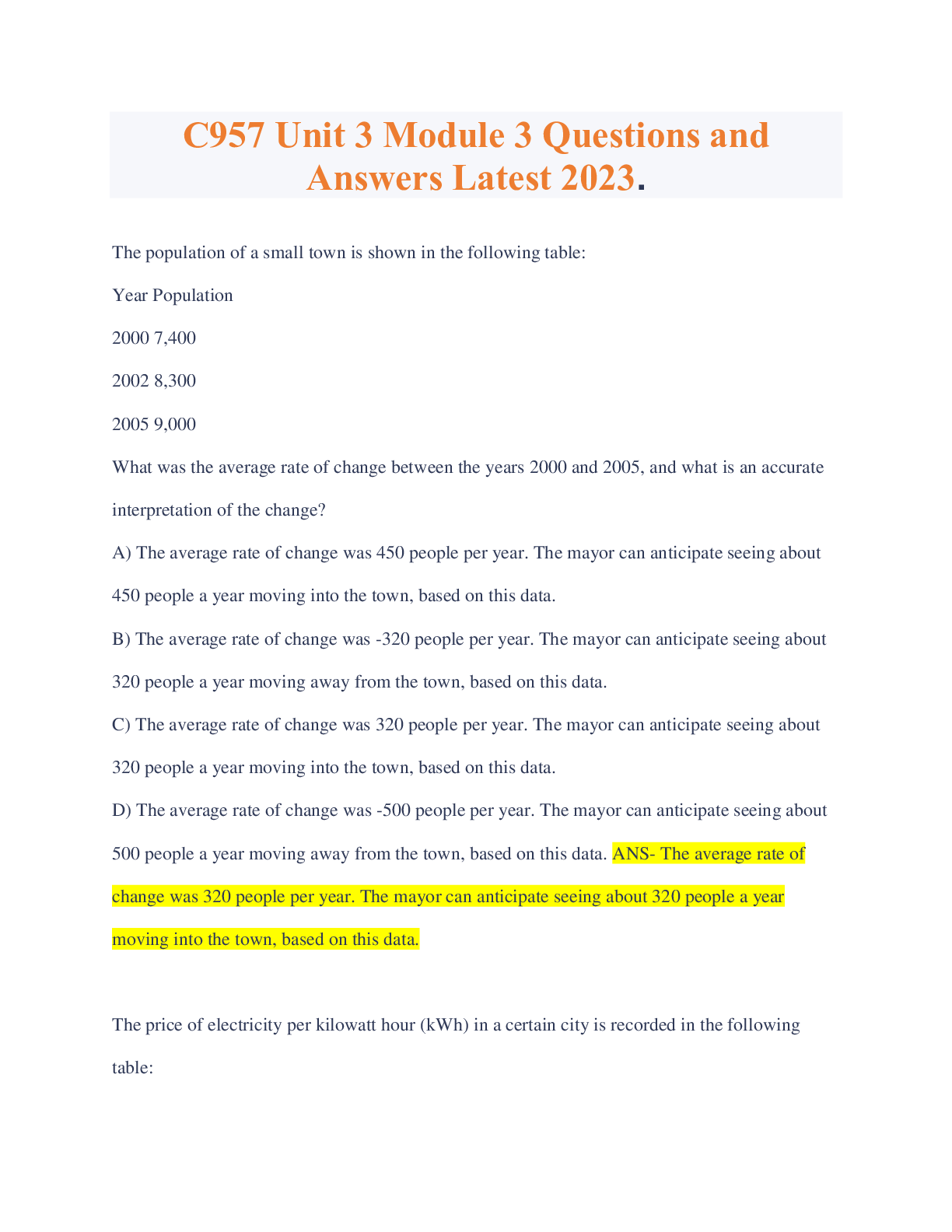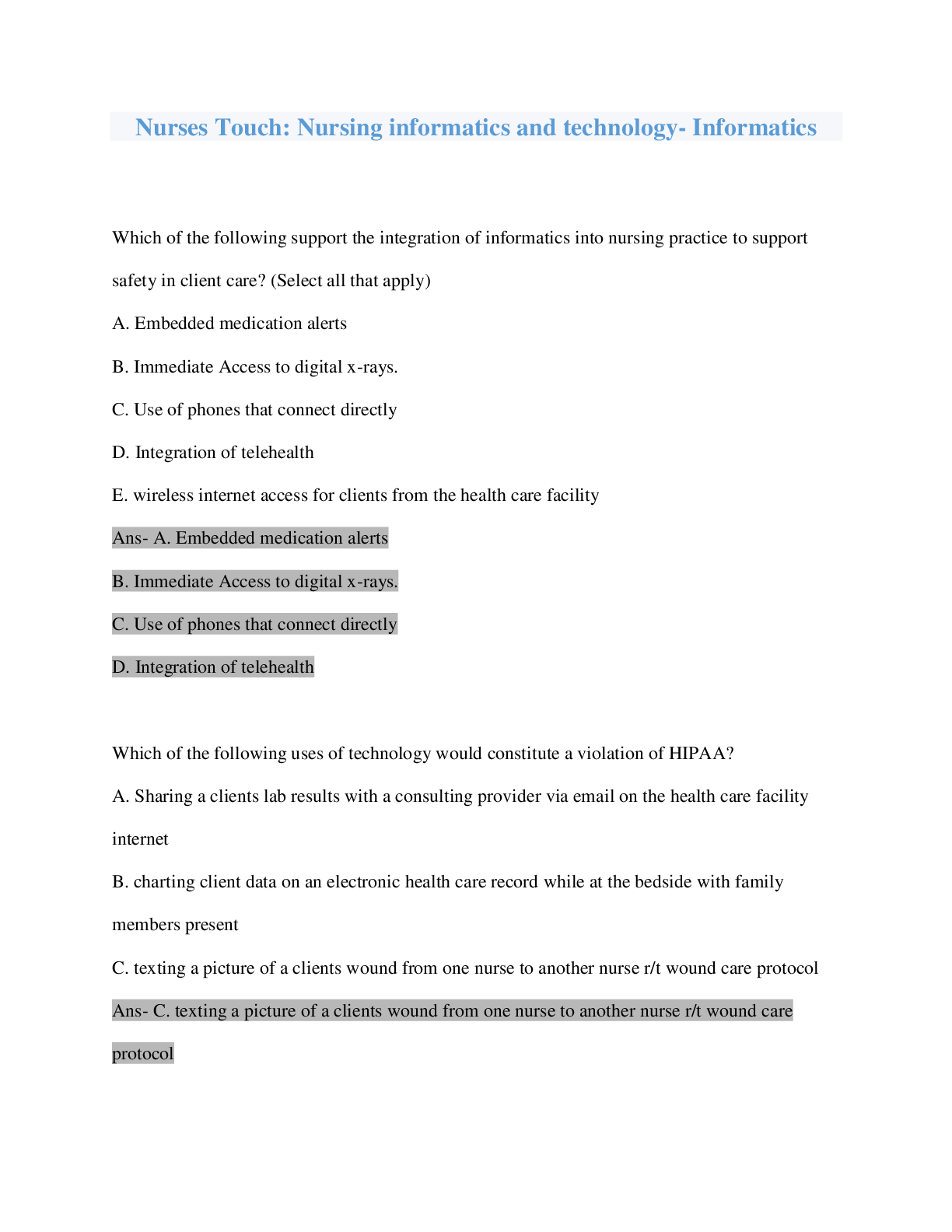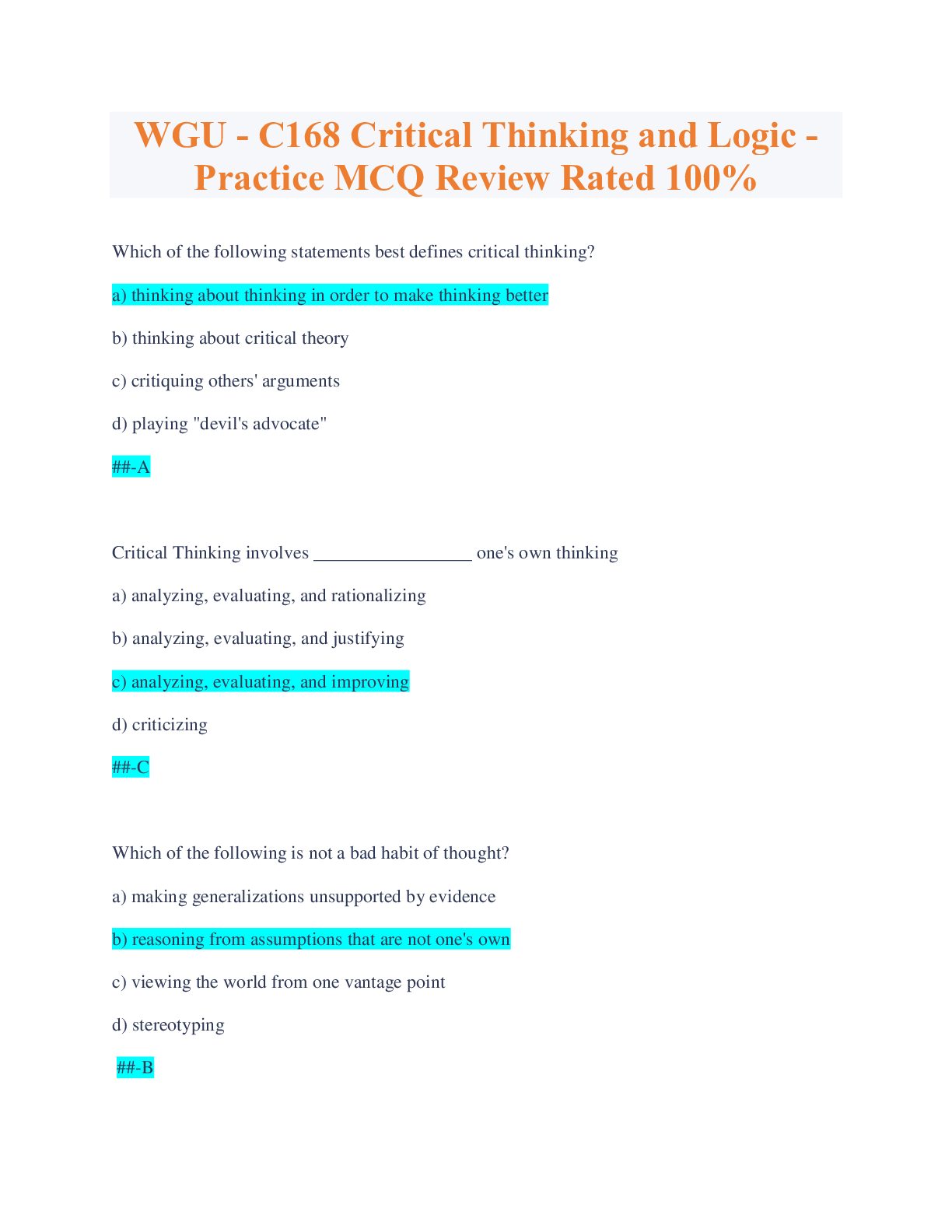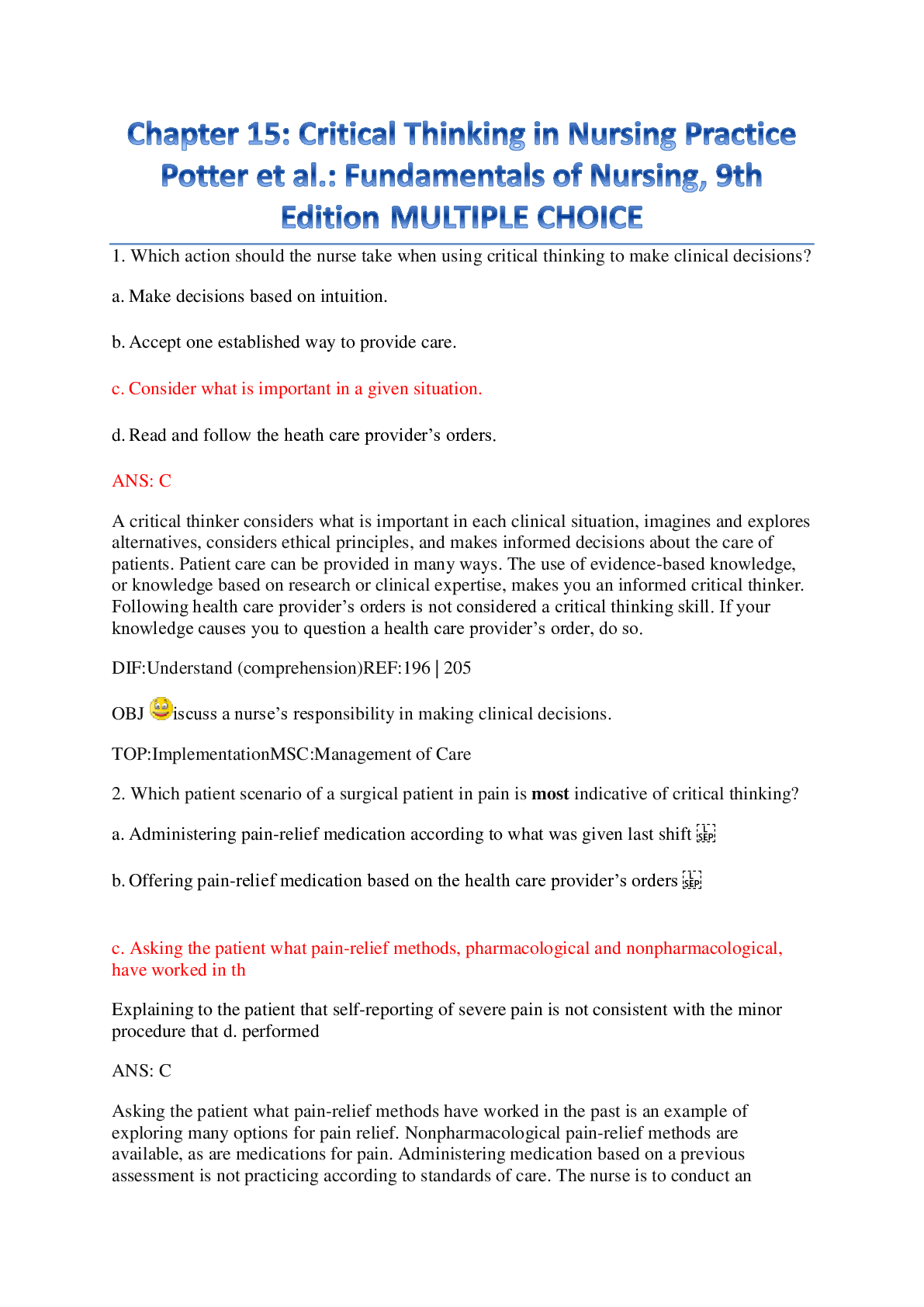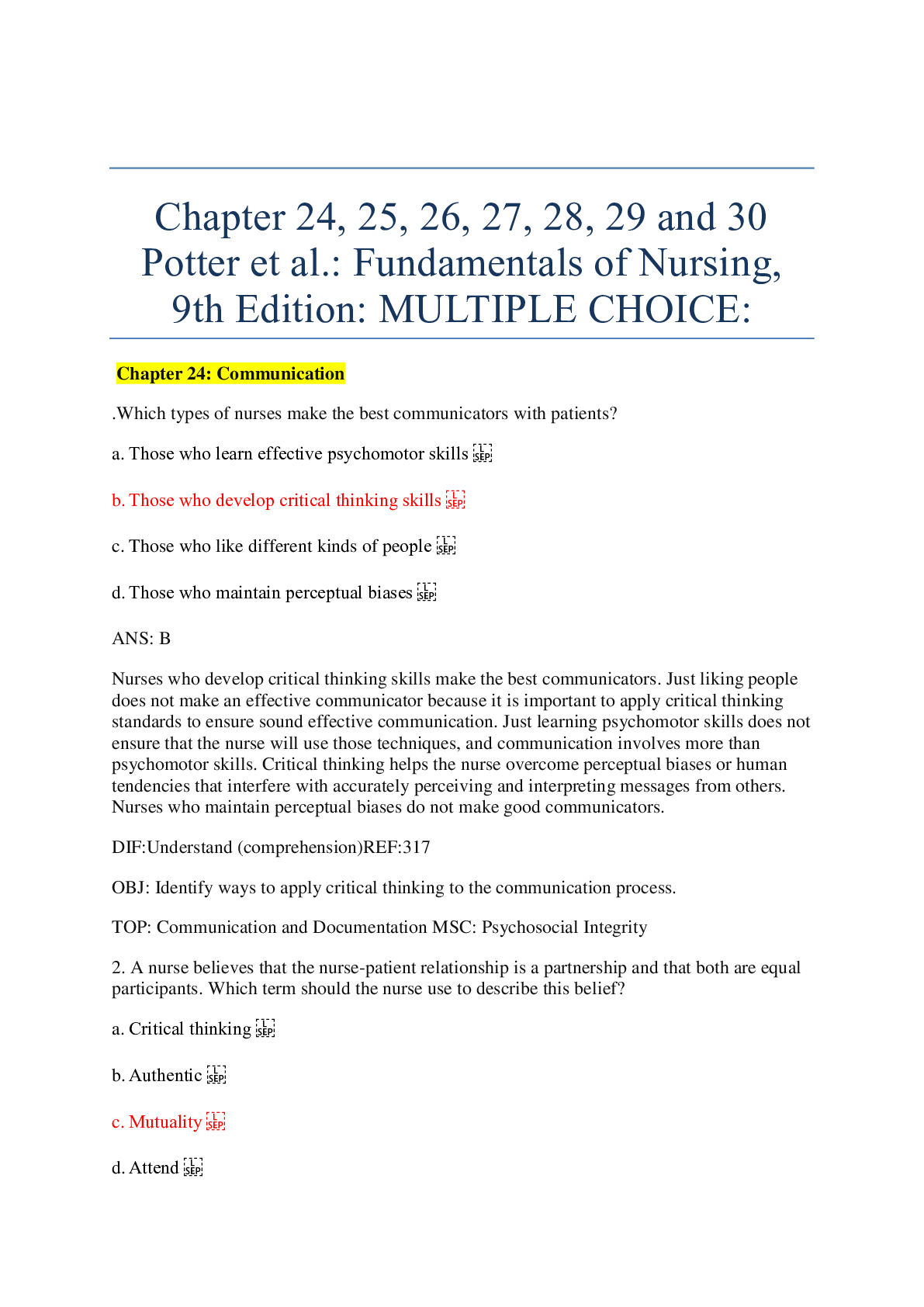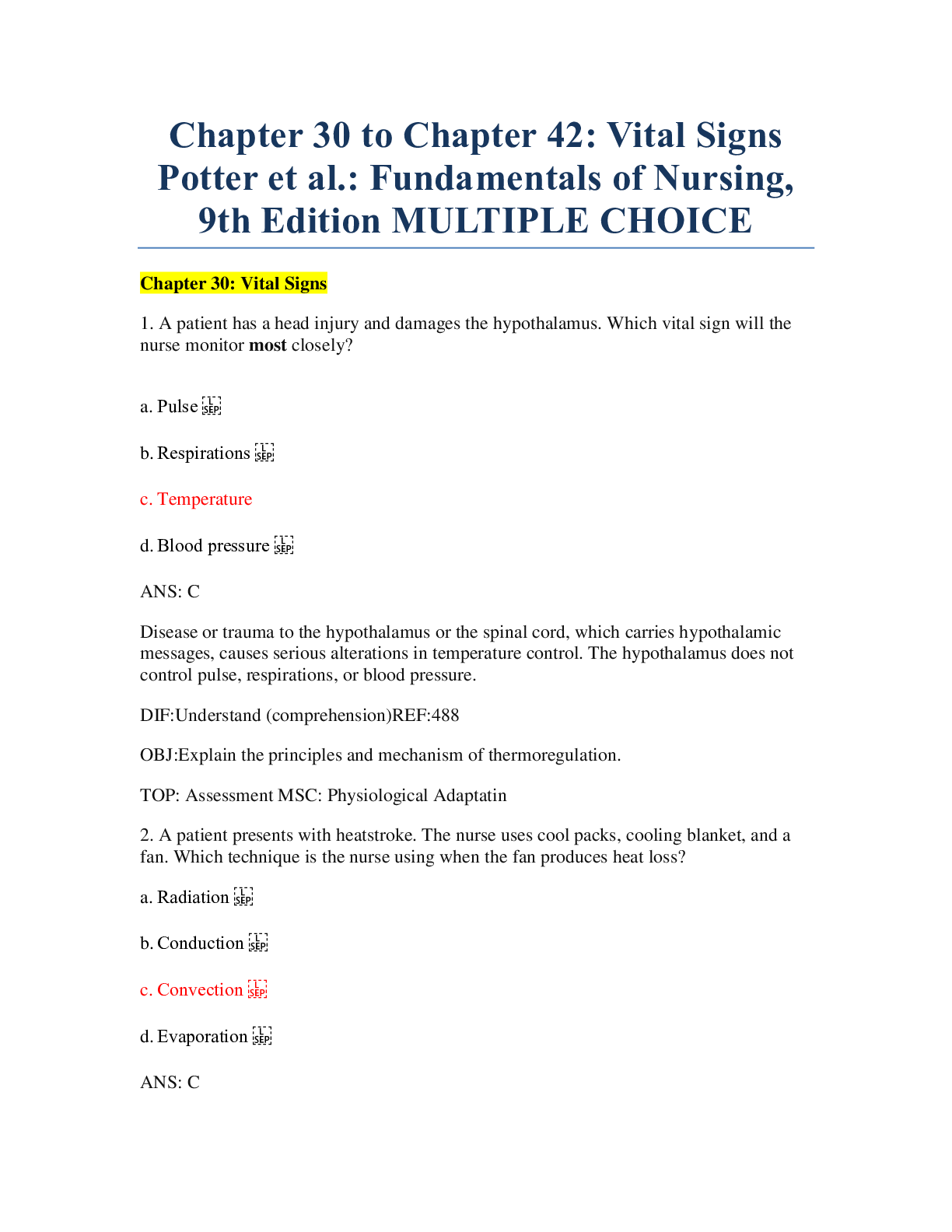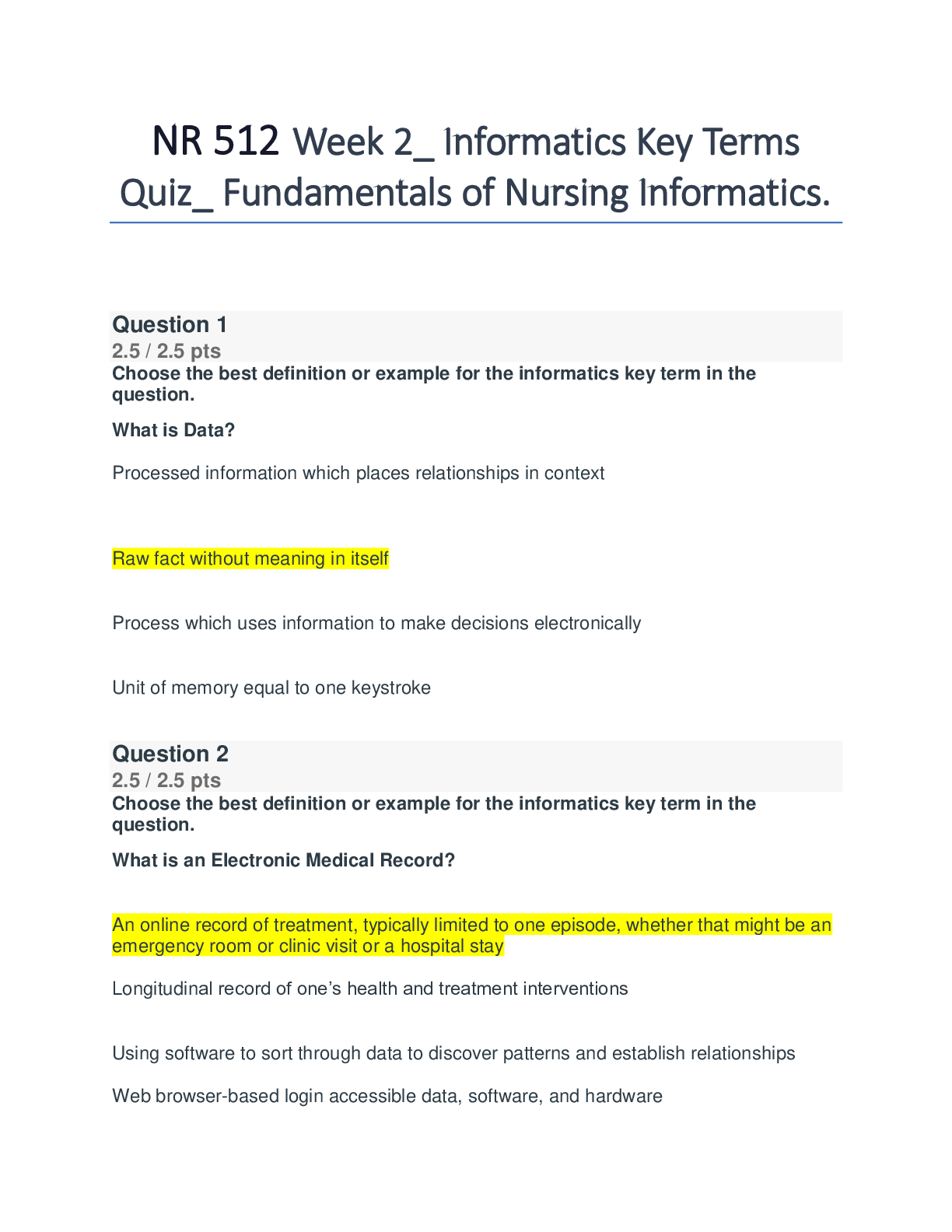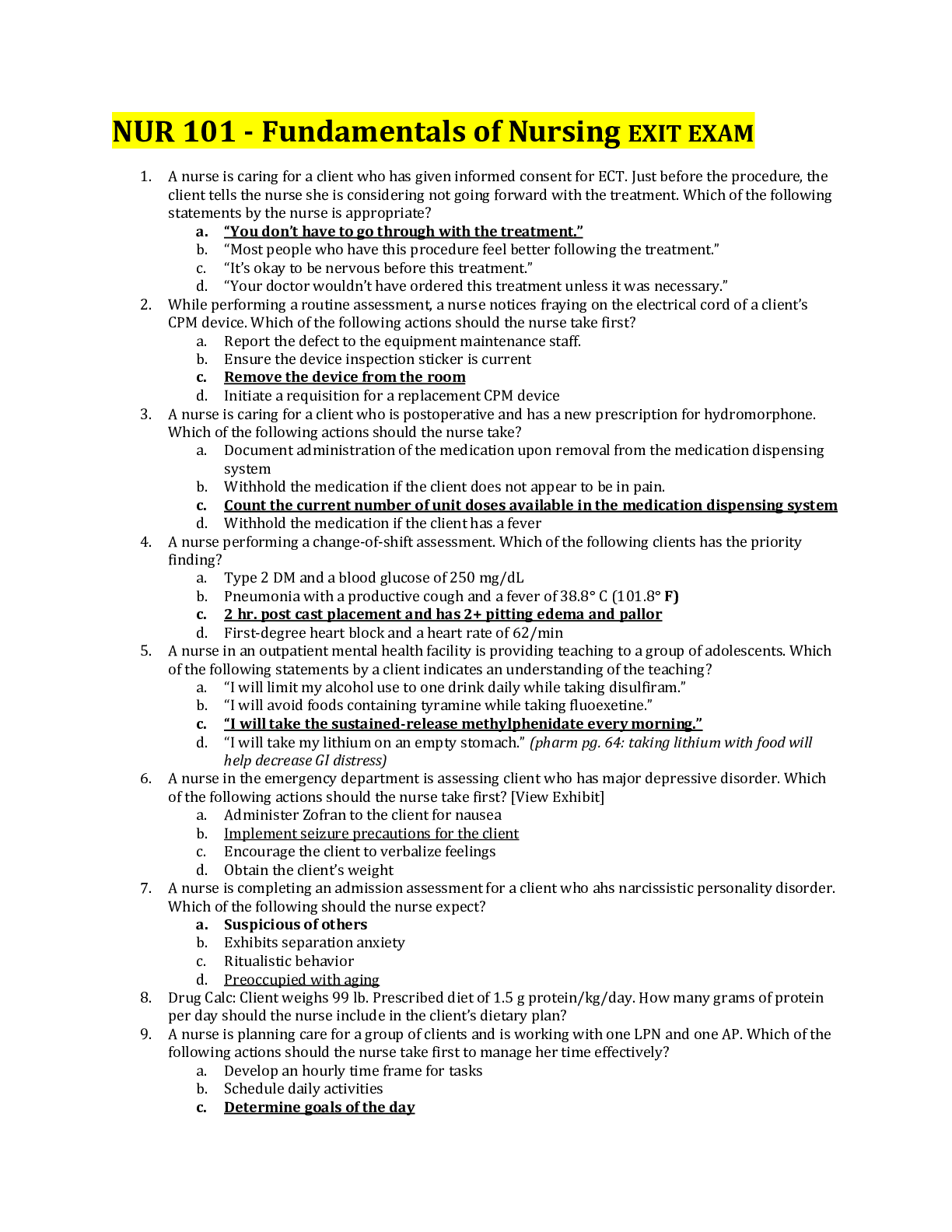*NURSING > QUESTIONS & ANSWERS > Nursing 101 Fundamentals of Nursing Practice Exam 1, Part 1 (All)
Nursing 101 Fundamentals of Nursing Practice Exam 1, Part 1
Document Content and Description Below
Nursing 101 Fundamentals of Nursing Practice Exam 1, Part 1 During a physical assessment, the nurse closes and door and provides drape to promote privacy. The nurse is performing her role as a/an: A... . Advocate B. Communicator C. Change agent D. Caregiver Ans- D. Caregiver The role of a nurse as caregiver helps client promote, restore and maintain dignity, health and wellness by viewing a person holistically. As an advocate the nurse intercedes or works on behalf of the client. Identifying the need and problems of the client and communicating it to other members of the health team is doing the role of a communicator. As a change agent, the nurse assists the client to MODIFY their BEHAVIOR. During the nursing rounds Nurse Cathy is instructing the patient to avoid smoking to prevent the worsening of respiratory problems. The patient asked about the things that he can do when feelings of wanting to smoke arises. The nurse enumerates ways of dealing the situation. This is an example of a nurse's role as a/an: A. Advocate B. Clinician C. Change agent D. Caregiver Ans- C. Change agent As a change agent, the nurse assists the client to MODIFY their BEHAVIOR. As an advocate the nurse intercedes or works on behalf of the client. As a clinician, the nurse would use technical expertise to administer nursing care. The role of a nurse as caregiver helps client promote, restore and maintain dignity, health and wellness by viewing a person holistically. Nurse Cathy on the other hand, knows the case immediately even before a diagnosis is done. Based on Benner's theory she is a/an: A. Novice B. Expert C. Competent D. Advanced beginner Ans- B. Expert The ability to perceive something without further evidence is the development of intuition and is seen in Expert nurses. A novice nurse is governed by rules and usually inflexible. Competent nurses are planning nursing care consciously. Advanced beginners demonstrate acceptable performance. Newborn screening is done to every newborn in the Philippines. This is an example of: A. Primary prevention B. Secondary prevention C. Tertiary prevention D. Rehabilitation Ans- B. Secondary prevention Promotion of early detection and early treatment of the disease is under secondary prevention. Example, breast self exam, TB screening, genetic counseling. One of Nurse Cathy's co-workers is Annie who is flexible in any given situation. Annie is performing her duties well without supervision but still needs more experience and practice to develop a consciously planned nursing care. According to Patricia Benner's category in specialization in nursing, Annie is a/an: A. Novice B. Expert C. Competent D. Advanced beginner Ans- D. Advanced beginner A- Novice is governed by rules and usually inflexible. B- Expert nurses have intuitive grasp on the situation dealt. C- Competent nurses are planning nursing care consciously. D- Advanced beginners demonstrate acceptable performance. The clinical instructor is discussing about the Nursing Process. She mentioned that when a cluster of actual or high-risk diagnosis are present because of a certain situation it is called: A. Wellness nursing diagnosis B. Actual nursing diagnosis C. Syndrome nursing diagnosis D. Risk nursing diagnosis Ans- C. Syndrome nursing diagnosis Presence of both actual and high-risk diagnosis is called a syndrome nursing diagnosis. Wellness nursing diagnosis focuses on the clinical judgment on an individual from a specific to higher level of wellness. Actual diagnoses are clinical judgment of the nurse that is validated. A risk diagnosis is based on the clinical are based on clinical judgment that the client may develop vulnerability to the problem. The nurse in charge measures a patient's temperature at 101 degrees F. What is the equivalent centigrade temperature? A. 36.3 degrees C B. 37.95 degrees C C. 40.03 degrees C D. 38.01 degrees C Ans- B. 37.95 To convert °F to °C use this formula, ( °F - 32 ) (0.55). While when converting °C to °F use this formula, ( °C x 1.8) + 32. Note that 0.55 is 5/9 and 1.8 is 9/5. During a change-of-shift report, it would be important for the nurse relinquishing responsibility for care of the patient to communicate. Which of the following facts to the nurse assuming responsibility for care of the patient? A. That the patient verbalized, "My headache is gone." B. That the patient's barium enema performed 3 days ago was negative C. Patient's NGT was removed 2 hours ago D. Patient's family came for a visit this morning. Ans- C. Patient's NGT was removed 2 hours ago The change-of-shift report should indicate significant recent changes in the patient's condition that the nurse assuming responsibility for care of the patient will need to monitor. The other options are not critical enough to include in the report A client is receiving 115 ml/hr of continuous IVF. The nurse notices that the venipuncture site is red and swollen. Which of the following interventions would the nurse perform first? A. Stop the infusion B. Call the attending physician C. Slow that infusion to 20 ml/hr D. Place a cold towel on the site Ans- A. Stop the infusion The sign and symptoms indicate extravasation so the IVF should be stopped immediately and put warm not cold towel on the affected site. Which data would be of greatest concern to the nurse when completing the nursing assessment of a 68-year-old woman hospitalized due to Pneumonia? A. Oriented to date, time and place B. Clear breath sounds C. Capillary refill greater than 3 seconds and buccal cyanosis D. Hemoglobin of 13 g/dl Ans- C. Capillary refill greater than 3 seconds and buccal cyanosis Capillary refill greater than 3 seconds and buccal cyanosis indicate decreased oxygen to the tissues which requires immediate attention/intervention. Oriented to date, time and place, hemoglobin of 13 g/dl are normal data. What is the order of the nursing process? A. Assessing, diagnosing, implementing, evaluating, planning B. Diagnosing, assessing, planning, implementing, evaluating C. Assessing, diagnosing, planning, implementing, evaluating D. Planning, evaluating, diagnosing, assessing, implementing Ans- C. Assessing, diagnosing, planning, implementing, evaluating The correct order of the nursing process is assessing, diagnosing, planning, implementing, evaluating. Which of the following is the most important purpose of planning care with a patient? A. Development of a standardized NCP. B. Expansion of the current taxonomy of nursing diagnosis C. Making of individualized patient care D. Incorporation of both nursing and medical diagnoses in patient care Ans- C. Making of individualized patient care To be effective, the nursing care plan developed in the planning phase of the nursing process must reflect the individualized needs of the patient. What nursing action is appropriate when obtaining a sterile urine specimen from an indwelling catheter to prevent infection? A. Use sterile gloves when obtaining urine B. Open the drainage bag and pour out the urine C. Disconnect the catheter from the tubing and get urine D. Aspirate urine from the tubing port using a sterile syringe Ans- D. Aspirate urine from the tubing port using a sterile syringe The nurse should aspirate the urine from the port using a sterile syringe to obtain a urine specimen. Opening a closed drainage system increase the risk of urinary tract infection. Jake is complaining of shortness of breath. The nurse assesses his respiratory rate to be 30 breaths per minute and documents that Jake is tachypneic. The nurse understands that tachypnea means: A. Pulse rate greater than 100 beats per minute B. Blood pressure of 140/90 C. Respiratory rate greater than 20 breaths per minute D. Frequent bowel sounds Ans- C. Respiratory rate greater than 20 breaths per minute A respiratory rate of greater than 20 breaths per minute is tachypnea. A blood pressure of 140/90 is considered hypertension. Pulse greater than 100 beats per minute is tachycardia. Frequent bowel sounds refer to hyper-active bowel sounds. Formulating a nursing diagnosis is a joint function of: A. Patient and relatives B. Nurse and patient C. Doctor and family D. Nurse and doctor Ans- B. Nurse and patient Although diagnosing is basically the nurse's responsibility, input from the patient is essential to formulate the correct nursing diagnosis. The nurse listens to Mrs. Sullen's lungs and notes a hissing sound or musical sound. The nurse documents this as: A. Wheezes B. Rhonchi C. Gurgles D. Vesicular Ans- A. Wheezes Wheezes are indicated by continuous, lengthy, musical; heard during inspiration or expiration. Rhonchi are usually coarse breath sounds. Gurgles are loud gurgling, bubbling sound. Vesicular breath sounds are low pitch, soft intensity on expiration. Becky is on NPO since midnight as preparation for blood test. Adreno-cortical response is activated. Which of the following is an expected response? A. Low blood pressure B. Warm, dry skin C. Decreased serum sodium levels D. Decreased urine output Ans- D. Decreased urine output Adreno-cortical response involves release of aldosterone that leads to retention of sodium and water. This results to decreased urine output. When performing an abdominal examination, the patient should be in a supine position with the head of the bed at what position? A. 30 degrees B. 90 degrees C. 45 degrees D. 0 degree Ans- D. 0 degree The patient should be positioned with the head of the bed completely flattened to perform an abdominal examination. If the head of the bed is elevated, the abdominal muscles and organs can be bunched up, altering the findings. Which of the following is inappropriate nursing action when administering NGT feeding? A. Place the feeding 20 inches above the point of insertion of NGT B. Introduce the feeding slowly C. Instill 60ml of water into the NGT after feeding D. Assist the patient in fowler's position Ans- A. Place the feeding 20 inches above the point of insertion of NGT The height of the feeding is above 12 inches above the point of insertion, bot 20 inches. If the height of feeding is too high, this results to very rapid introduction of feeding. This may trigger nausea and vomiting During application of medication into the ear, which of the following is inappropriate nursing action? A. In an adult, pull the pinna upward B. Instill the medication directly into the tympanic membrane C. Warm the medication at room or body temperature D. Press the tragus of the ear a few times to assist flow of medication into the ear canal Ans- B. Instill the medication directly into the tympanic membrane During the application of medication it is inappropriate to instill the medication directly into the tympanic membrane. The right thing to do is instill the medication along the lateral wall of the auditory canal. Kussmaul's breathing is: A. Shallow breaths interrupted by apnea B. Prolonged gasping inspiration followed by a very short, usually inefficient expiration C. Marked rhythmic waxing and waning of respirations from very deep to very shallow breathing and temporary apnea D. Increased rate and depth of respiration Ans- D. Increased rate and depth of respiration Kussmaul breathing is also called as hyperventilation. Seen in metabolic acidosis and renal failure. Option A refers to Biot's breathing. Option B is apneustic breathing and option C is the Cheyne-stokes breathing. The nurse is aware that Bell's palsy affects which cranial nerve? A. 2nd CN (Optic) B. 3rd CN (Occulomotor) C. 4th CN (Trochlear) D. 7th CN (Facial) Ans- D. 7th CN (Facial) Bells' palsy is the paralysis of the motor component of the 7th cranial nerve, resulting in facial sag, inability to close the eyelid or the mouth, drooling, flat naso-labial fold and loss of taste on the affected side of the face. When performing an admission assessment on a newly admitted patient, the nurse percusses resonance. The nurse knows that resonance heard on percussion is most commonly heard over which organ? A. Thigh B. Liver C. Intestine D. Lung Ans- D. Lung Resonance is loud, low-pitched and long duration that's heard most commonly over an air-filled tissue such as a normal lung. To assess the adequacy of food intake, which of the following assessment parameters is best used? A. Food preferences B. Regularity of meal times C. 3-day diet recall D. Eating style and habits Ans- C. 3-day diet recall 3-day diet recall is an example of dietary history. This is used to indicate the adequacy of food intake of the client. Claire is admitted with a diagnosis of chronic shoulder pain. By definition, the nurse understands that the patient has had pain for more than: A. 3 months B. 6 months C. 9 months D. 1 year Ans- B. 6 months Chronic pain is usually defined as pain lasting longer than 6 months. It is the gradual decrease of the body's temperature after death: A. Livor mortis B. Rigor mortis C. Algor mortis D. none of the above Ans- C. Algor mortis Algor mortis is the decrease of the body's temperature after death. Livor mortis is the discoloration of the skin after death. Rigor mortis is the stiffening of the body that occurs about 2-4 hours after death. Prolonged deficiency of Vitamin B9 leads to: A. Scurvy B. Pellagra C. Megaloblastic anemia D. Pernicious anemia Ans- C. Megaloblastic Prolonged Vitamin B9 deficiency will lead to megaloblastic anemia while pernicious anemia results in deficiency in Vitamin B12. Prolonged deficiency of Vitamin C leads to scurvy and Pellagra results in deficiency in Vitamin B3. Pia's serum sodium level is 150 mEq/L. Which of the following food items does the nurse instruct Pia to avoid? A. Broccoli B. Sardines C. Cabbage D. Tomatoes Ans- D. Sardines The normal serum sodium level is 135 to 145 mEq/L, the client is having hypernatremia. Pia should avoid food high in sodium like processed food. Broccoli, cabbage and tomatoes are good source of Vitamin C. When assessing a patient's level of consciousness, which type of nursing intervention is the nurse performing? A. Independent B. Dependent C. Collaborative D. Professional Ans- A. Independent Independent nursing interventions involve actions that nurses initiate based on their own knowledge and skills without the direction or supervision of another member of the health care team. Which of the following is a nursing diagnosis? A. Hypothermia B. Diabetes Mellitus C. Angina D. Chronic Renal Failure Ans- A. Hypothermia Hyperthermia is a NANDA-approved nursing diagnosis. Diabetes Mellitus, Angina and Chronic Renal Failure are medical diagnoses. A skin lesion which is fluid-filled, less than 1 cm in size is called: A. Papule B. Vesicle C. Bulla D. Macule Ans- B. Vesicle Vesicle is a circumscribed circulation containing serous fluid or blood and less than 1 cm (ex. Blister, chicken pox). S1 is heard best at the: A. 5th left intercostal space along the midclavicular line B. 3rd intercostal space to the left of the midclavicular line C. Second right intercostal space at the sternal border D. Second left intercostal space at the sternal border Ans- A. 5th left intercostal space along the midclavicular line The S1 heart sound is best heard at the apex of the heart, at the fifth intercostal space along the midclavicular line. (An infant's apex is located at the third or fourth intercostal space just to the left of the midclavicular line) The correct site at which to verify a radial pulse measurement is the: A. Brachial artery B. Apex of the heart C. Temporal artery D. Inguinal site Ans- B. Apex of the heart The best site for verifying a pulse rate is the apex of the heart, where the heartbeat is measured directly. To promote correct anatomic alignment in a supine patient, the nurse should: A. Place the patient's feet in dorsiflexion B. Place a pillow under the patient's knees C. Hyperextend the patient's neck D. Adduct the patient's shoulder Ans- A. Place the patient's feet in dorsiflexion Anatomic alignment prevents strain on body parts, maintains balance, and promotes physiologic functioning. To promote this position, the nurse should place the feet in dorsiflexion (at right angles to the legs). Postural drainage to relieve respiratory congestion should take place: A. Before meals B. After meals C. At the nurse's convenience D. At the patient's convenience Ans- A. Before meals Postural drainage is best performed before, rather after meals to avoid tiring the patient or inducing vomiting. The patient's safety supersedes the convenience in scheduling this procedure. Mr. Jose is admitted to the hospital with a diagnosis of pneumonia and COPD. The physician orders an oxygen therapy for him. The most comfortable method of delivering oxygen to Mr. Jose is by: A. Croupette B. Nasal cannula C. Nasal catheter D. Partial rebreathing mask Ans- B. Nasal cannula The nasal cannula is the most comfortable method of delivering oxygen because it allows the patient to talk, eat and drink. The nurse's main priority when caring for a patient with hemiplegia? A. Educating the patient B. Providing a safe environment C. Promoting a positive self-image D. Helping the patient accept the illness Ans- B. Providing a safe environment A patient with hemiplegia (paralysis of one side of the body) has a high risk of injury because of his altered motor and sensory function, so safety is the nurse's main priority. A sudden redness of the skin is known as: A. Flush B. Cyanosis C. Jaundice D. Pallor Ans- A. Flush Flush is a sudden redness of the skin. Cyanosis is a slightly bluish, grayish skin discoloration caused by abnormal amounts or reduced hemoglobin in the blood. Jaundice is a yellow discoloration of the skin, mucous membranes and sclera caused by excessive amounts of bilirubin in the blood. Pallor is an unnatural paleness or absence of color in the skin indicating insufficient oxygen and excessive carbon dioxide in the blood. A patient states that he has difficulty sleeping in the hospital because of noise. Which of the following would be an appropriate nursing action? A. Administer a sedative at bedtime, as ordered by the physician B. Ambulate the patient for 5 minutes before he retires C. Give the patient a glass of warm milk before bedtime D. Close the patient's door from 9pm to 7am Ans- C. Give the patient a glass of warm milk before bedtime Warm milk will relax the patient because it contains tryptophan, a natural sedative. If a patient sues a nurse for malpractice, the patient must be able to prove: A. Error, proximal cause, and lack of concern B. Error, injury and proximal cause C. Injury, error and assault D. Proximal cause, negligence and nurse error Ans- B. Error, injury and proximal cause Three criteria must be met to establish malpractice: a nursing error, a patient injury, and a connection between the two. Which of the following nursing theorists is credited with developing a conceptual model specific to nursing, with man as the central focus? A. Martha Rogers B. Dorothea Orem C. Florence Nightingale D. Sister Callista Roy Ans- A. Martha Rogers Martha Roger's life process model views man as an evolving creature interacting with the environment in an open, adaptive manner. According to this model, the purpose of nursing is to help man achieve maximum health in his environment. Which of the following nursing theorists developed a conceptual model based on the belief that all persons strive to achieve self-care? A. Martha Rogers B. Dorothea Orem C. Florence Nightingale D. Sister Callista Roy Ans- B. Dorothea Orem Dorothea Orem's conceptual model is based on the premise that all persons need to achieve self-care. She also views the goal of nursing as helping the patient to develop self-care practices to maintain maximum wellness. The average daily amount of urine excreted by an adult is: A. 500 to 600 ml B. 800 to 1,400 ml C. 1,000 to 1,200 ml D. 1,500 to 2,000 ml Ans- D. 1,500-2,000 ml An adult's average urine output ranges between 1,500 and 2,000 ml/day. The nurse should take a rectal temperature of a patient who has: A. His arm in a cast B. Nasal packing C. External hemorrhoids D. Gastrostomy feeding tubes Ans- B. Nasal packing A rectal temperature is usually recommended whenever an oral temperature is contraindicated (e.g. the patient who have undergone oral or nasal surgery, infants and those who have history of seizures, etc.). However, a rectal temperature is contraindicated in patients having rectal disease, rectal surgery or diarrhea) The usual sequence for assessing the bowel is: A. Right lower quadrant, right upper quadrant, left upper quadrant, left lower quadrant B. Right lower lobe, right upper lobe, left upper lobe, left lower lobe C. Right hypochondriac, left hypochondriac and umbilical regions D. Rectum, pancreas, stomach and liver Ans- A. Right lower quadrant, right upper quadrant, left upper quadrant, left lower quadrant This sequence follows the anatomy of the bowel. The lobes are parts of the lung. the right and left hypochondriac and the umbilical area are three of the nine regions of the abdomen. Constipation is a common problem for immobilized patients because of: A. Decreased tightening of the anal sphincter B. An increased defecation reflex C. Decreased peristalsis and positional discomfort D. Increased colon motility Ans- C. Decreased peristalsis and positional discomfort Increased adrenalin production in the immobile patient results in decrease peristalsis and colon motility and more tightly constricted sphincters. According to Maslow's hierarchy of needs, which of the following is a basic physiologic need after oxygen? A. Safety B. Activity C. Love D. Self esteem Ans- B. Activity According to Maslow, activity is one of the man's most basic physiologic needs, along with oxygen, shelter, food, water, thirst, sleep and temperature maintenance. The term gavage indicates: A. Administration of a liquid feeding into the stomach B. Visual examination of the stomach C. Irrigation of the stomach with a solution D. A surgical opening through the abdomen to the stomach Ans- A. Administration of a liquid feeding into the stomach Gavage is the administration of a liquid feeding into the stomach. Which communication skills is most effective in dealing with covert communication? A. Clarification B. Listening C. Evaluation D. Validation Ans- D. Validation Covert communication reflects inner feelings that a person may be uncomfortable talking about. Such communication may be revealed through body language, silence, withdrawn behavior, or crying. Validation is an attempt to confirm the observer's perceptions through feedback, interpretation and clarification. [Show More]
Last updated: 11 months ago
Preview 1 out of 28 pages
Instant download

Buy this document to get the full access instantly
Instant Download Access after purchase
Add to cartInstant download
Reviews( 0 )
Document information
Connected school, study & course
About the document
Uploaded On
Jul 03, 2023
Number of pages
28
Written in
Additional information
This document has been written for:
Uploaded
Jul 03, 2023
Downloads
0
Views
104


